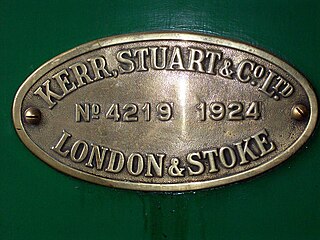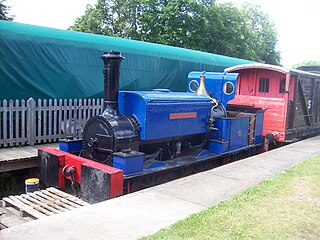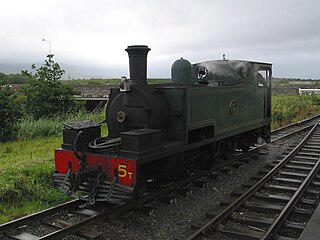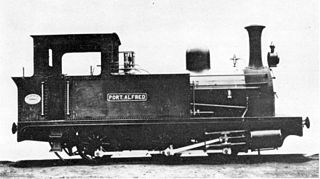
The Hunslet Engine Company is a locomotive-building company, founded in 1864 in Hunslet, England. It manufactured steam locomotives for over 100 years and currently manufactures diesel shunting locomotives. The company is part of Ed Murray & Sons.

The Hunslet Austerity 0-6-0ST is a class of steam locomotive designed by Hunslet Engine Company for shunting. The class became the standard British shunting locomotive during the Second World War, and production continued until 1964 at various locomotive manufacturers.

The London, Midland and Scottish Railway (LMS) Fowler 3F0-6-0T is a class of steam locomotives, often known as Jinty. They represent the ultimate development of the Midland Railway's six-coupled tank engines. They could reach speeds of up to 60 mph (97 km/h).

The Cavan & Leitrim Railway was a 3 ft narrow gauge railway in the counties of Leitrim and Cavan in northwest Ireland, which ran from 1887 until 1959. Unusually for Ireland, this 3 ft narrow gauge line survived on coal traffic, from the mine at Arigna, although the original main line was constructed principally for traffic in cattle. It outlived most of the other Irish narrow-gauge lines, giving a further lease of life to some of their redundant engines.

Kerr, Stuart and Company Ltd was a locomotive manufacturer in Stoke-on-Trent, England.

W. G. Bagnall was a locomotive manufacturer from Stafford, England which was founded in 1875 and operated until it was taken over in 1962 by English Electric.

Manning Wardle was a steam locomotive manufacturer based in Hunslet, Leeds, West Yorkshire, England.

The NS 8800 was a series of tank engines of the Dutch railway NS for the shunting service. Of the approximately 324 British-built Hunslet Austerity C (0-6-0ST) saddle tank locomotives, many were used by the British War Department during their fight against the German army in mainland Western Europe. The NS bought 27 of them just after World War II. They had been built by the Hunslet Engine Company (12), WG Bagnall (3), Robert Stephenson & Hawthorns (RSH) (6) and Hudswell Clarke (6).

The Timoleague and Courtmacsherry Light Railway, opened in April 1891, was originally operated by two locomotives, both from the Leeds works of the Hunslet Engine Company, named Slaney and St. Molaga. These two were joined by a third locomotive, again from Hunslet in 1894. This third locomotive carried the name Argadeen and under the classification adopted by the Great Southern Railways on amalgamation in 1925 became the sole representative of Class K5.
The Avonside Engine Company was a locomotive manufacturer in Avon Street, St. Philip's, Bristol, England between 1864 and 1934. However the business originated with an earlier enterprise Henry Stothert and Company.
Tralee and Dingle Light Railway 7 and 8 were two 2-6-0T locomotives manufactured by Kerr, Stuart and Company in 1902 and 1903 for the Tralee and Dingle Light Railway.
The Tralee and Dingle Light Railway (TDLR) locomotives 1, 2, 3, 6, and 8 were 2-6-0T locomotives manufactured by the Hunslet Engine Company of Leeds, England between 1889 and 1910.

Tralee and Dingle Light Railway 5 is a 2-6-2T locomotive manufactured by the Hunslet Engine Company in 1892 for the Tralee and Dingle Light Railway.

The Cork and Muskerry Light Railway was a 3 ft narrow gauge railway in County Cork, Ireland. The first part of the railway opened in 1887 and closed in 1934. A major reason for building the railway was to exploit tourist traffic to Blarney Castle.

The Dinorwic Alice Class is a class of eleven narrow-gauge 0-4-0ST steam locomotives built specifically for the Dinorwic Slate Quarry. These locomotives were built by the Hunslet Engine Company between 1886 and 1904, and were designed and supplied specifically to work the many galleries of the quarry at Llanberis, North Wales.
Tube-gauge steam locomotives may appear to be an unlikely possibility, because of the problems of using such a machine in the confines of a tunnel less than 12-foot (3.7 m) in diameter, but the London Underground had three such vehicles over the years. Two were built by the Hunslet Engine Company in 1899, and the third by Kerr, Stuart and Company in 1922.

The Kowie Railway 0-6-0T of 1882 was a South African steam locomotive from the pre-Union era in the Cape of Good Hope.
The Timoleague and Courtmacsherry Railway was a 9 miles (14 km) long light railway connecting Timoleague station and Courtmacsherry station. It was the last roadside railway operating in Ireland.
Dublin, Wicklow and Wexford Railway (DW&WR) 50 and 51 were two 0-6-0 tender locomotives built in 1891 at Vulcan Works and were named Arklow and New Ross respectively. These were the first the 0-6-0 wheel configuration to be purchased by the DW&WR. The DW&WR's own Grand Canal Street were to construct two more in 1899/1900 and to follow that with a design for five more from 1904. The DW&WR became the Dublin and South Eastern Railway (DSER) from the end of 1906. Under the locomotive engineer R. Cronin both engines were rebuilt with Belpaire boilers in 1912 and 1915 respectively and the boiler pressure increased to 160 lb.












